- Home
- »
- Pharmaceuticals
- »
-
Anticoagulants Market Size, Share & Growth Report, 2030GVR Report cover
![Anticoagulants Market Size, Share & Trends Report]()
Anticoagulants Market Size, Share & Trends Analysis Report By Route of Administration (Oral Anticoagulants, Injectable Anticoagulants), By Drug Category, By Application (Atrial fibrillation, Pulmonary embolism), By Region, And Segment Forecasts, 2024 - 2030
- Report ID: GVR-4-68040-191-0
- Number of Report Pages: 125
- Format: PDF, Horizon Databook
- Historical Range: 2018 - 2022
- Forecast Period: 2024 - 2030
- Industry: Healthcare
Anticoagulants Market Size & Trends
The global anticoagulants market size was valued at USD 34.8 billion in 2023 and is expected to grow at a compound annual growth rate (CAGR) of 8.74% from 2024 to 2030. The rising prevalence of cardiovascular diseases, such as deep vein thrombosis, pulmonary embolism, and atrial fibrillation, aided by the growing aging population who are more prone to conditions that require anticoagulant therapy, are major factors driving the growth of market. According to WHO, by 2050, it is projected that the global population of people who are 60 years old or older will reach 2.1 billion.
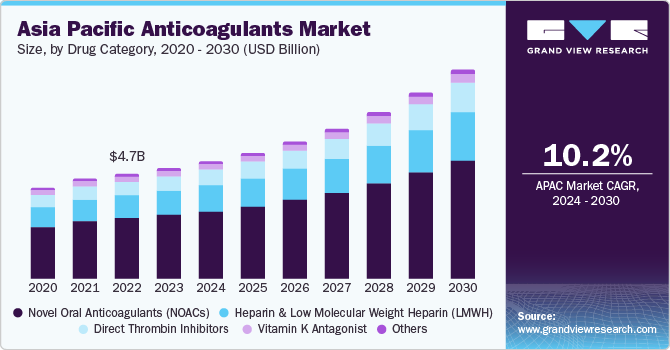
Additionally, it is expected that the number of individuals aged 80 years and above are expected to triple by 2050, with a projected number of 426 million. The growing strategic initiatives by the key operating players in the anticoagulants market are expected to offer lucrative opportunities for industry growth during the forecast period. For instance, in December 2021, FDA approved Johnson & Johnson Services, Inc. two pediatric indications for XARELTO, a direct oral anticoagulant. It is used as a primary prevention of clots in pediatric patients and treatment of venous thromboembolism.
According to World Obesity Atlas 2023, global levels of overweight and obesity cases are expected to reach 4 billion people by 2035, compared with over 2.6 billion in 2020. This reflects an increase from 38% of the world’s population in 2020 to over 50% by 2035. The prevalence of obesity alone is predicted to rise from 14% to 24% of the population over the same period. The increasing prevalence of obesity is a major factor driving market growth. Obesity is a significant risk factor for a number of chronic conditions, such as heart disease, stroke, and venous thromboembolism (VTE). These conditions require the use of anticoagulants to prevent blood clots. In addition, obese individuals have other associated factors that lead to blood clots, such as high blood pressure, diabetes, and smoking. This further increases the need for anticoagulants.
Furthermore, increasing incidence of stroke is projected to propel the market growth during the forecast period. Blood thinners are used for stroke prevention in individuals at risk due to various conditions, such as atrial fibrillation, certain heart valve disorders, and previous strokes. As per CDC, over 795,000 individuals in the U.S. experience stroke every year, out of which approximately 610,000 are first-time or new strokes. The death rate due to stroke has risen from 38.8 per 100,000 in 2020 to 41.1 per 100,000 in 2021. These statistics highlight the importance of raising awareness about stroke prevention and the need for timely medical intervention in case of an emergency. These rising stroke cases are expected to support market growth in forecast period.
Market Concentration & Characteristics
The market has witnessed a significant degree of innovation in recent years. Advances in pharmacogenomics allow for more personalized anticoagulant therapy. Genetic testing helps identify patients who respond differently to certain medications, allowing for tailored treatment plans. Innovations in monitoring technologies improves the management of anticoagulant therapy. Point-of-care devices and home monitoring kits allow patients to conveniently monitor their coagulation status. This can enhance adherence to treatment plans and reduce the need for frequent clinic visits. AI and machine learning applications have the potential to assist healthcare providers in predicting patient responses to anticoagulant therapy, optimizing dosage regimens, and identifying patients at higher risk of complications.
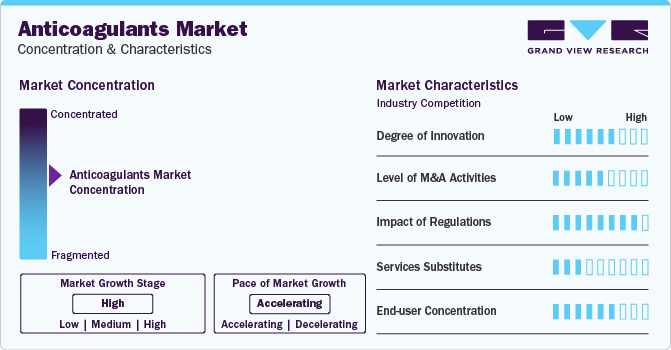
Pharmaceutical companies engage in M&A activities to expand their product portfolios and enter new therapeutic areas. Acquiring or merging with companies that have novel drug candidates or established products can be a strategic move to diversify offerings. Companies pursue M&A to gain access to innovative technologies related to anticoagulant development, formulation, or drug delivery. This can enhance their research and development capabilities, potentially leading to the introduction of more advanced anticoagulant therapies.
Regulatory agencies, such as the U.S. Food and Drug Administration (FDA), the European Medicines Agency (EMA), and other national regulatory bodies, set stringent standards for the approval and registration of anticoagulant drugs. The regulatory process involves extensive preclinical and clinical trials to demonstrate the safety and efficacy of new anticoagulant therapies.
Compression stockings are a non-pharmacological approach to preventing DVT in individuals at risk. These stockings apply pressure to the legs, promoting blood circulation and reducing the likelihood of clot formation. In certain situations, mechanical interventions serve as substitutes or adjuncts to anticoagulant therapy.
Hospitals are major end users of anticoagulant therapies, particularly for acute conditions such as DVT, pulmonary embolism, and post-surgical prophylaxis. Ambulatory care centers, including specialized anticoagulation clinics, contribute to end-user concentration by providing targeted anticoagulation management services. These centers often focus on monitoring and adjusting anticoagulant therapy, ensuring patient adherence, and preventing complications.
Drug Category Insights
Novel oral anticoagulants (NOACs) segment dominated the market with a revenue share of 57.2% in 2023. The growth of the segment is attributed to rising adoption of NOACs in developing countries as preferred option over warfarin owing to its effectiveness and safety. NOACs offer fixed dosing regimens and predictable pharmacokinetic profiles, eliminating the need for frequent monitoring and dose adjustments required with warfarin. This enhances patient compliance and convenience. NOACs have fewer drug interactions compared to warfarin, reducing the risk of adverse reactions and complications from interacting medications. NOACs are administered orally, eliminating the need for injections or subcutaneous administration, which can be inconvenient or uncomfortable for patients. In addition, governments, and insurance providers have gradually adopted favorable reimbursement policies for NOACs, making them more accessible to patients.
Heparin and Low Molecular Weight Heparin (LMWH) segment is anticipated to grow at fastest CAGR during the forecast period. The indications for heparin and LMWH are expanding into acute treatment to include prevention in high-risk patients, such as those undergoing major surgery or experiencing prolonged immobilization. This expanded use is contributing to segment growth. Increasing prevalence of thrombotic events is fueling the demand for heparin and LMWH. Furthermore, heparin and LMWH are often considered cost-effective anticoagulant options, especially in resource-limited healthcare settings. The affordability and effectiveness of these agents make them attractive choices in various healthcare systems globally.
Route of Administration Insights
Oral anticoagulants segment held the largest share in 2023 in market and is anticipated to grow at fastest growth rate over the forecast period. This segment witnessed notable growth in patient convenience, improved compliance, and advancements in drug development. Oral anticoagulants offer a convenient and patient-friendly alternative to traditional injectable forms. This is particularly crucial for long-term therapy, where patient adherence to the prescribed treatment regimen is essential. The ease of administration contributes significantly to the overall preference for oral anticoagulants among healthcare providers and patients. Several pharmaceutical companies are actively engaged in the development and commercialization of oral anticoagulants. Key players focus on innovations, such as novel formulations and improved safety profiles, to gain a competitive edge. For instance, in December 2020, NATCO Pharma Limited launched the Rivaroxaban molecule under the brand name RPIGAT. Rivaroxaban is an oral anticoagulant medication used for the treatment of blood clots. It is available in four strengths: 20, 15, 10, and 2.5 mg.
Injectable anticoagulants segment is expected to grow significantly during the forecast period. The growth of the segment is due to its increasing use in the treatment of various medical conditions such as deep vein thrombosis, pulmonary embolism, and atrial fibrillation. These anticoagulants are administered through injections and have a quicker onset of action compared to oral anticoagulants. Additionally, the prevalence of chronic conditions such as atrial fibrillation (AF), deep vein thrombosis (DVT), and pulmonary embolism (PE) is increasing globally. These conditions require anticoagulant therapy to prevent blood clots, which can lead to serious complications such as stroke and heart attack. These factors are expected to support the injectable anticoagulants segment in the forecast years.
Application Insights
Atrial fibrillation/myocardial infarction (heart attack) segment dominated the market. Atrial fibrillation is a common heart condition that can lead to blood clots and stroke, and anticoagulants are an effective treatment option for reducing the risk of these complications. With the increasing prevalence of atrial fibrillation, the demand for anticoagulants is on a rise and the atrial fibrillation application segment has emerged as a key driver of growth in the market. According to CDC estimates, by 2030, around 12.1 million individuals in the US are expected to suffer from atrial fibrillation. In addition, factors such as rising healthcare expenditure and increasing awareness about the benefits of anticoagulants have also contributed to the growth.
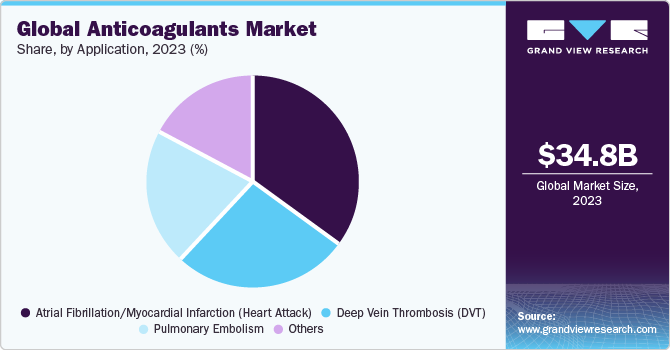
Deep Vein Thrombosis (DVT) segment is expected to grow at fastest growth rate during the projected period. The prevalence of DVT is on the rise globally, driven by factors such as an aging population, increased sedentary lifestyles, and rising obesity rates. For instance, according to CDC, around 900,000 people are affected by DVT annually in U.S. The use of anticoagulants is expanding further in acute treatment in DVT management to include long-term prophylaxis for patients at high risk of recurrent DVT. This extended use is contributing to the segment's growth.
Regional Insights
North America accounted for the largest revenue share in 2023 in market. The growth of the market in the region is attributed to the high demand for innovative products and the increasing prevalence of cardiovascular disorders. According to CDC, in February 2022, heart diseases resulted in deaths of about 659,000 individuals annually, representing almost 25% of all U.S. deaths. This increase in cardiovascular diseases has resulted in an increase in demand for anticoagulants. Furthermore, the presence of top pharma and biotech companies involved in the development of therapeutics, along with the well-established healthcare infrastructure, is also fueling the growth of regional market. Some of the major players operating in the market are Pfizer Inc., Endo International plc, and Baxter International, Inc. The presence of these leading players in the market is expected to increase the availability of anticoagulants in the region.
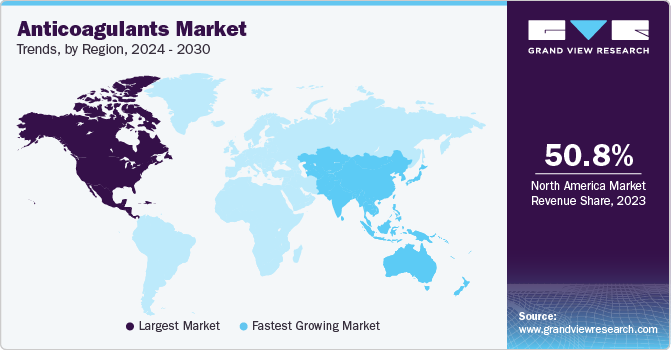
The Asia Pacific region is expected to grow at the fastest CAGR in the market due to the increasing prevalence of chronic diseases, growing geriatric population, and rising healthcare expenditure in the region. Additionally, factors such as rising awareness about the benefits of early diagnosis and treatment of blood clots, increasing investments in the healthcare sector, and advancements in technology are also contributing to the growth of the market in this region. For instance, in April 2023, Sirnaomics Ltd. announced the launch of Phase I clinical trial of STP122G using the GalNAc Factor XI Program. The platform is applicable for a wide range of disease indications as an anticoagulant therapeutic.
Key Anticoagulants Company Insights
Some of the key players operating in the market include Aspen Holdings, Sanofi, Boehringer Ingelheim International GmbH, and DAIICHI SANKYO COMPANY, LIMITED.
-
Sanofi is a global pharmaceutical company having a global presence and operations in over 100 countries. The company specializes in developing, manufacturing, and marketing pharmaceuticals for a wide range of diseases, including immunology, oncology, cardiovascular diseases, diabetes, and central nervous system disorders.
-
Boehringer Ingelheim International GmbH is a pharmaceutical company having a major focus on developing innovative medicines for humans and animals. The company has three reportable segments: human pharma, animal health, biopharma contract manufacturing.
- Anthos Therapeutics, AcelRx Pharmaceuticals, Inc., Sirnaomics are some of the emerging market participants in the market.
-
AcelRx Pharmaceuticals, Inc. is a pharmaceutical company focusing on the development and commercialization of therapies majorly focusing on the treatment of pain and related conditions.
-
Sirnaomics is a biopharmaceutical company involved in the development of therapeutics using RNA interference technology for critical human diseases.
Key Anticoagulants Companies:
The following are the leading companies in the anticoagulants market. These companies collectively hold the largest market share and dictate industry trends. Financials, strategy maps & products of these anticoagulants companies are analyzed to map the supply network.
- Aspen Holdings
- Pfizer Inc.
- Bristol-Myers Squibb Company
- GSK plc
- Sanofi
- Bayer AG
- Boehringer Ingelheim International GmbH
- DAIICHI SANKYO COMPANY, LIMITED
- Johnson & Johnson Services, Inc.
- Eisai Co., Ltd.
Recent Developments
-
In November 2023, Pharmascience Canada announced the launch of the generic drug (Pr) pms-RIVAROXABAN, a medicine that belongs to the group of anticoagulants (blood thinners), that helps in preventing blood clots by directly blocking the activity of Factor Xa.
-
In July 2023, Endo International plc. launched bivalirudin injection in ready-to-use (RTU) vials in the U.S. with the collaboration of Gland Pharma Limited, India, and MAIA Pharmaceuticals, Inc. The new RTU vials of bivalirudin are expected to be more convenient and efficient for healthcare professionals.
-
In July 2020, Alexion Pharmaceuticals Inc. acquired Portola Pharmaceuticals, Inc., a clinical-stage biopharmaceutical company focused on developing and commercializing novel therapies for the treatment of blood-related disorders.
Anticoagulants Market Report Scope
Report Attribute
Details
Market size value in 2024
USD 36.5 billion
Revenue forecast in 2030
USD 60.4 billion
Growth rate
CAGR of 8.7% from 2024 to 2030
Base year for estimation
2023
Historical data
2018 - 2022
Forecast period
2024 - 2030
Quantitative units
Revenue in USD billion/million and CAGR from 2024 to 2030
Report coverage
Revenue forecast, company ranking, competitive landscape, growth factors, and trends
Segments covered
Drug Category, route of Administration, application, region
Regional scope
North America; Europe; Asia Pacific; Latin America; MEA
Country scope
U.S.; Canada; Germany; UK; France; Italy; Spain; Denmark; Sweden; Norway; China; Japan; India; South Korea; Australia; Thailand; Brazil; Mexico; Argentina; Saudi Arabia; UAE; Kuwait; South Africa
Key companies profiled
Aspen Holdings; Pfizer Inc.; Bristol-Myers Squibb Company; GSK plc; Sanofi, Bayer AG; Boehringer Ingelheim International GmbH; DAIICHI SANKYO COMPANY, LIMITED; Johnson & Johnson Services Inc.; Eisai Co., Ltd.
Customization scope
Free report customization (equivalent up to 8 analysts working days) with purchase. Addition or alteration to country, regional & segment scope.
Pricing and purchase options
Avail customized purchase options to meet your exact research needs. Explore purchase options
Global Anticoagulants Market Report Segmentation
This report forecasts revenue growth at global, regional, and country levels and provides an analysis of the latest industry trends in each of the sub-segments from 2018 to 2030. For this study, Grand View Research has segmented the global anticoagulants market report based on drug category, route of administration, application, and region.
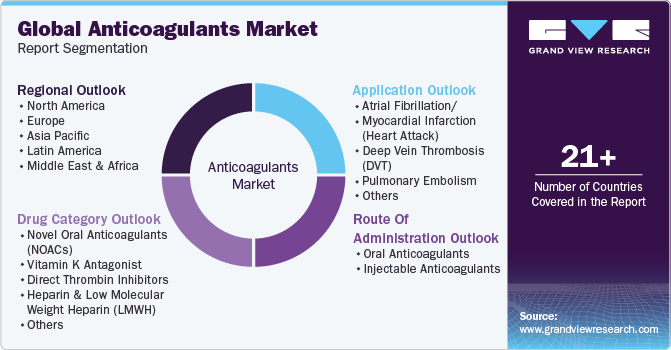
-
Drug Category Outlook (Revenue, USD Million, 2018 - 2030)
-
Novel Oral Anticoagulants (NOACs)
-
Eliquis
-
Xarelto
-
Savaysa & Lixiana
-
Pradaxa
-
-
Vitamin K Antagonist
-
Direct Thrombin Inhibitors
-
Heparin and Low Molecular Weight Heparin (LMWH)
-
Others
-
-
Route of Administration Outlook (Revenue, USD Million, 2018 - 2030)
-
Oral Anticoagulants
-
Injectable Anticoagulants
-
-
Application Outlook (Revenue, USD Million, 2018 - 2030)
-
Atrial Fibrillation/Myocardial Infarction (Heart Attack)
-
Deep Vein Thrombosis (DVT)
-
Pulmonary Embolism
-
Others
-
-
Regional Outlook (Revenue, USD Million, 2018 - 2030)
-
North America
-
U.S.
-
Canada
-
-
Europe
-
Germany
-
UK
-
France
-
Italy
-
Spain
-
Denmark
-
Sweden
-
Norway
-
-
Asia Pacific
-
China
-
Japan
-
India
-
South Korea
-
Thailand
-
Australia
-
-
Latin America
-
Brazil
-
Mexico
-
Argentina
-
-
Middle East and Africa (MEA)
-
South Africa
-
Saudi Arabia
-
UAE
-
Kuwait
-
-
Frequently Asked Questions About This Report
b. The global anticoagulants market size was valued at USD 34.80 billion in 2023 and is expected to reach USD 36.55 billion in 2024.
b. The global anticoagulants market is expected to expand at a compound annual growth rate (CAGR) of 8.74% from 2024 to 2030 to reach USD 60.43 billion by 2030.
b. Novel oral anticoagulants (NOACs) segment dominated the anticoagulants market with a revenue share of 57.27% in 2023. The growth of the segment is attributed to the rising adoption of NOACs in developing countries as the preferred option over warfarin owing to its effectiveness and safety.
b. Some key players operating in the anticoagulants market include Aspen Holdings; Pfizer Inc.; Bristol-Myers Squibb Company; GSK plc; Sanofi, Bayer AG; Boehringer Ingelheim International GmbH; DAIICHI SANKYO COMPANY, LIMITED; Johnson & Johnson Services Inc.; Eisai Co., Ltd.
b. Key factors that are driving the market growth include the rising prevalence of cardiovascular diseases, such as deep vein thrombosis, pulmonary embolism, and atrial fibrillation, aided by the growing aging population who are more prone to conditions that require anticoagulant therapy,
Share this report with your colleague or friend.
![gvr icn]()
NEED A CUSTOM REPORT?
We can customize every report - free of charge - including purchasing stand-alone sections or country-level reports, as well as offer affordable discounts for start-ups & universities. Contact us now
![Certified Icon]()
We are GDPR and CCPA compliant! Your transaction & personal information is safe and secure. For more details, please read our privacy policy.
We are committed towards customer satisfaction, and quality service.
"The quality of research they have done for us has been excellent."





